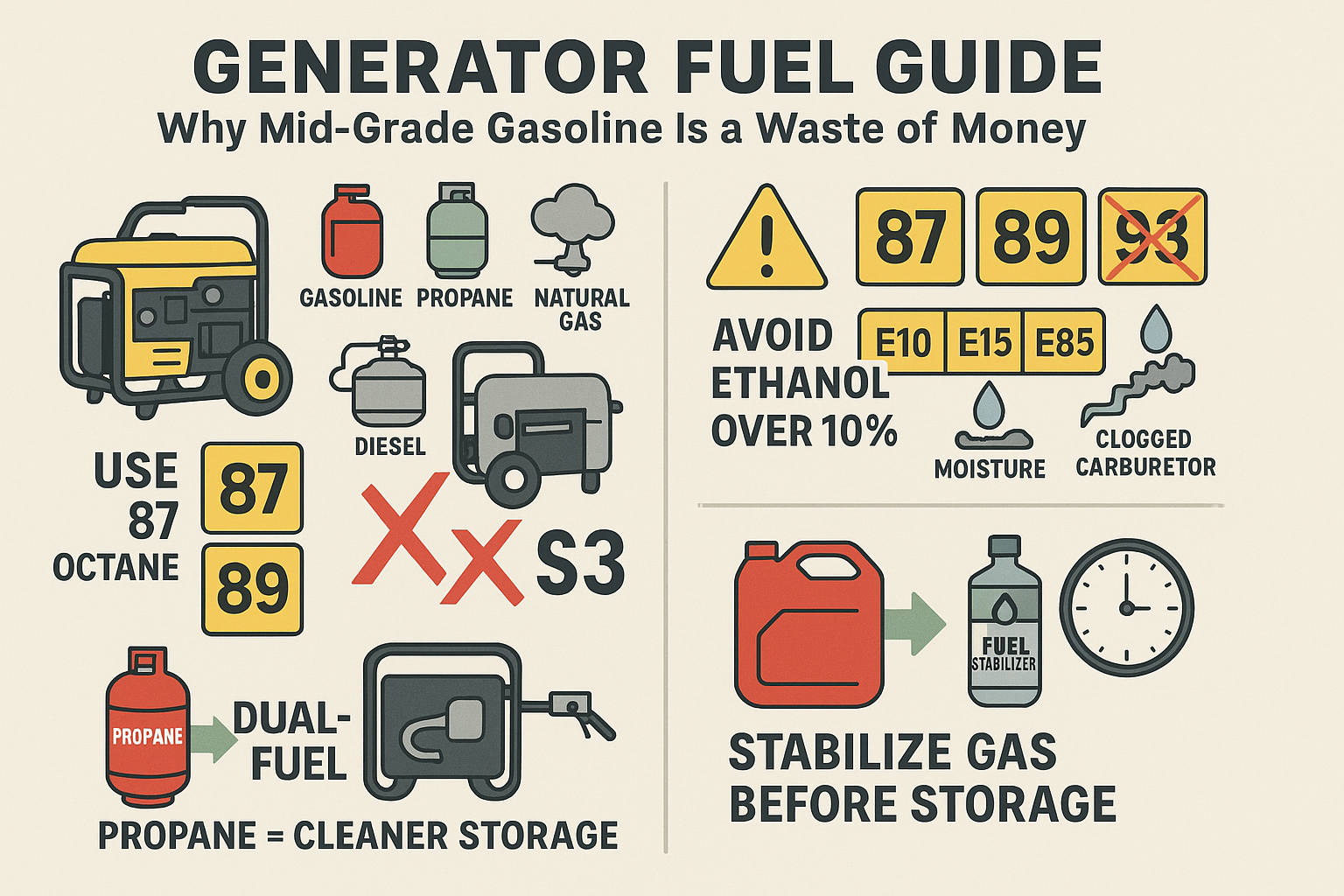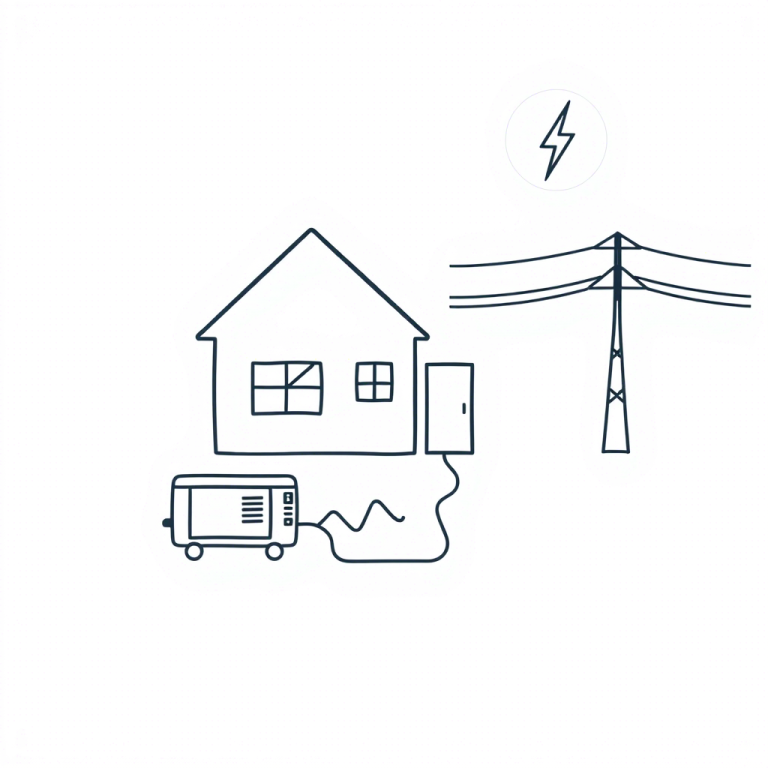Can I Use Mid Grade Gas in My Generator? Fuel Compatibility Guide
Generators are lifelines during power outages, off-grid adventures, and job sites. But while choosing a reliable generator is critical, many overlook a major factor that directly impacts performance, longevity, and cost: fuel selection.
This comprehensive guide unpacks the science behind generator fuel compatibility, debunks myths about mid-grade gasoline, explores ethanol-related risks, and provides expert tips for safe fuel storage and smarter long-term planning.
Understanding Generator Fuel Basics
Generators convert chemical energy from fuel into electricity through internal combustion. The quality and type of fuel used directly affect combustion efficiency, engine health, emissions, and maintenance costs.
Gasoline is the most common fuel for portable generators. However, not all gasoline is created equal—especially when comparing different octane levels. In automotive culture, mid-grade and premium fuels are often misunderstood as “better,” but for generators, this assumption is both incorrect and costly.
Most generator engines are designed specifically for regular unleaded gasoline (87 octane), and using higher-octane fuels like mid-grade (89) or premium (91–93) offers no performance gain—just unnecessary expense.
The Mid-Grade Myth: Why Higher Octane Doesn’t Help
1. Octane Misconceptions Explained
Octane rating is not a measure of fuel quality or power; it’s a measure of the fuel’s resistance to knocking (pre-ignition). Knock resistance only matters in high-compression engines, such as those found in sports cars and motorcycles.
Fact: Most portable generator engines have compression ratios below 10:1—far below the threshold that requires higher-octane fuel.
2. Manufacturer Guidelines Are Clear
Top generator manufacturers consistently recommend regular unleaded fuel (87 octane):
- Honda: “Our engines are certified and designed to run on regular unleaded gasoline.”
- Champion: Recommends “unleaded gasoline with an ethanol content of 10% or less.”
- DuroMax: Notes that while “87 octane or higher is acceptable,” there’s “no noticeable difference.”
Bottom line: Paying more for mid-grade or premium gas offers no improvement in performance, reliability, or engine protection—just a 15–30% increase in fuel cost.
The Real Threat: Ethanol Content in Modern Gasoline
1. The Ethanol Problem
Ethanol-blended fuels dominate the market, but ethanol introduces several critical issues for small engines:
- Moisture Attraction: Ethanol absorbs water from the air, leading to phase separation, which causes:
- Corroded fuel tanks and lines
- Blocked carburetor jets
- Engine misfires and hard starts
- Reduced Energy Density: Ethanol contains about 28% less energy than pure gasoline, decreasing power output and runtime.
- Solvent Effect: Ethanol dissolves old fuel deposits and varnish, carrying them into the carburetor where they form clogs.
2. The 10% Ethanol Threshold
Most generators can tolerate up to E10 (10% ethanol). However:
- E15 or E85 fuels are strictly prohibited in small engines.
- Honda warns: “Do not use E85. It can damage components and cause poor starting or performance.”
- Untreated E10 gasoline can go stale in as little as 30 days, forming sticky gums that clog fuel systems.
Fuel Storage and Maintenance Solutions
1. Fuel Stabilization Techniques
Proper storage can extend fuel life from weeks to years:
- Use a stabilizer (like STA-BIL) for any gasoline stored longer than 30 days.
- After adding stabilizer:
- Run the generator for 10–15 minutes to circulate treated fuel.
- Turn off the fuel valve and let the engine run dry to protect the carburetor.
2. Go Ethanol-Free (If You Can)
Non-ethanol gasoline (also called pure gas or E0) is the best option for long-term storage and minimal maintenance.
- Available at select gas stations (see: www.Pure-Gas.org)
- Especially ideal for:
- Backup generators used seasonally
- Equipment that may sit idle for months
3. Proper Long-Term Storage Checklist
- Add stabilizer to fresh gas and run engine to circulate it.
- Shut the fuel valve and run carb dry.
- Drain tank if storing beyond 6 months.
- Add 2 tablespoons of oil into the spark plug hole; pull recoil starter to lubricate cylinder.
- Disconnect the battery (if applicable).
- Store in a dry, cool, well-ventilated area.
Comparison Table: Generator Fuel Options
| Fuel Type | Shelf Life | Safety | Best Use | Drawbacks |
|---|---|---|---|---|
| Gasoline (87 Octane) | 12 months (with stabilizer) | Low (highly flammable) | Portable generators | Ethanol-related issues, short shelf life |
| Propane | Indefinite | Medium (pressurized) | Emergency backup & storage | Slightly reduced power output (~10–15%) |
| Diesel | 18–24 months | High (less volatile) | Industrial/heavy-duty setups | Noisy, risk of wet stacking at light loads |
| Natural Gas | Continuous supply | Medium (leak risk) | Whole-home stationary systems | Needs utility connection; may fail in outages |
Practical Alternatives to Gasoline
1. Propane Conversion Kits
Convert a gasoline generator to run on propane:
- Kits cost between $100–$300
- Benefits:
- Indefinite shelf life
- Fewer emissions
- No gumming or ethanol issues
- Drawbacks:
- Slight loss in power output (~10–15%)
Case Study: An RV owner ran a 7,500W generator exclusively on propane for 7 years—zero fuel-related issues.
2. Dual-Fuel Generators
Brands like Champion and DuroMax offer models that seamlessly switch between gasoline and propane:
- Added fuel flexibility during emergencies
- Great for areas with inconsistent fuel supply
- Using propane for storage helps avoid carburetor clogging
Special Cases: When Higher Octane Might Matter (Rarely)
There are only niche scenarios where high-octane fuel could be useful:
- Heavily modified engines with advanced timing adjustments (rare in consumer generators)
- High-compression diesel engines (require high cetane—not octane)
- Knocking due to mechanical problems (should be addressed via repair, not premium fuel)
For standard generators: high octane is unnecessary.
Expert Maintenance Checklist
| Task | Frequency |
|---|---|
| Add fuel stabilizer | Every fill-up if stored >30 days |
| Run generator under load | Monthly, 15 minutes |
| Drain carburetor | Before long-term storage |
| Inspect for leaks, filters | After long storage |
| Change oil/spark plug | Every 100 hours or annually |
| Clean fuel system | Every season or if stalling |
Safety and Efficiency Best Practices
- Carbon Monoxide Safety: Always run generators outdoors, at least 20 feet from doors and windows.
- Fire Risk: Store fuel in UL-approved containers, away from ignition sources.
- Efficiency Tip: Operate diesel generators at 70–80% load to prevent wet stacking (excess unburned fuel).
Final Verdict: Skip the Mid-Grade
Mid-grade gasoline offers no added benefits for generator performance or engine health. Instead, it wastes money while doing nothing to prevent common fuel-related problems.
- Use regular unleaded (87 octane)
- Avoid ethanol levels above 10%
- Add fuel stabilizer for any storage beyond 30 days
- Consider propane or dual-fuel options
- Opt for ethanol-free gas when possible
By understanding fuel chemistry and following proven maintenance protocols, you can maximize your generator’s reliability and lifespan—without wasting money at the pump.


